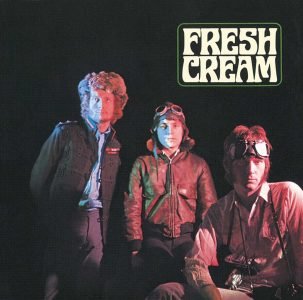Released in December 1966, Fresh Cream marked the debut of British power trio Cream, a band that brought together three musicians already renowned in their own right: Eric Clapton, Jack Bruce, and Ginger Baker. The album arrived at a time when British rock was rapidly evolving, with bands like The Rolling Stones and The Yardbirds pushing blues into new, electrified territory. Cream stood out by aiming to blend blues roots with a more adventurous, improvisational edge, something rarely heard in mainstream rock at the time.
As a first statement, Fresh Cream is less a radical break and more a sharpening of what had come before. It builds on the blues revival and jazz-inspired experiments that had been bubbling in the UK, especially in the underground club scene. While Clapton had previously leaned heavily into blues with John Mayall’s Bluesbreakers, this project widened the lens. Cream’s vision here was to explore how traditional blues could be stretched, electrified, and intensified within a rock format. In interviews from the era, the band expressed a desire to focus on musical interplay and push the limits of a three-piece setup, aiming for a raw yet technically accomplished sound.
Sonic Exploration

From the first notes of Fresh Cream, it’s clear the album is rooted in a raw and unpolished sonic world. The production, handled by Robert Stigwood and engineered by John Timperley, avoids the studio gloss that was beginning to surface in late-60s rock. Instead, the album leans into a stripped-back, almost live feel. This choice suits the band’s power trio format, allowing the listener to hear each instrument distinctly without studio tricks clouding the mix. While this approach adds urgency and grit, it also means some tracks lack the depth or polish found in more ambitious productions from the same period.
Musical Arrangements
The instrumental arrangements are where Cream starts to show their teeth. Jack Bruce’s bass doesn’t just hold down rhythm—it often drives the melody, locking in with Ginger Baker’s expressive drumming to create a dense, almost jazzy undercurrent. Clapton’s guitar is, of course, a focal point, and his tone on tracks like “Spoonful” and “Sleepy Time Time” is thick and biting. His solos are forceful but restrained compared to what would come later in the band’s career. Vocally, Bruce and Clapton share duties, though Bruce’s stronger blues phrasing often carries more emotional weight. There are moments, however, where the vocals feel slightly buried in the mix, a possible consequence of the quick production schedule.
Genre-wise, Fresh Cream is firmly grounded in electric blues and British blues rock. It occasionally dips into jazz-inflected rhythms and early hard rock textures, especially in the instrumental “Cat’s Squirrel” and the energetic “N.S.U.” The album doesn’t try to fuse genres in any radical way, but it does stretch the boundaries of blues rock just enough to hint at where the band might go next. What’s missing, perhaps, is the psychedelic influence that would come to define later Cream records. This makes Fresh Cream feel more like a focused homage than a fully formed reinvention.
Lyrical Analysis

Lyrically, Fresh Cream keeps its feet firmly planted in blues tradition. The album explores familiar themes of heartbreak, longing, frustration, and defiance, often through direct and unembellished language. Tracks like “I Feel Free” and “Spoonful” speak to desire and emotional yearning, while “N.S.U.” hints at disillusionment and detachment. These are not complex narratives or conceptually dense songs, but they capture moods that were central to the late-60s rock and blues aesthetic.
The lyrics tend to be straightforward and functional, often serving as vehicles for the band’s instrumental expression rather than standing on their own as poetic statements. “Sleepy Time Time,” for example, features simple blues phrasing that supports the slow-burning groove, while “Rollin’ and Tumblin’” sticks closely to traditional blues structure and language. There’s a certain charm in this simplicity, but it can also feel limiting. The words rarely push boundaries or delve into more introspective or philosophical territory, which may leave some listeners wanting more depth or nuance.
Despite this, there is emotional resonance to be found. The delivery, especially by Jack Bruce, gives even the simplest lines a sense of urgency and feeling. When he sings about isolation or frustration, it doesn’t need to be elaborate to be effective. The band’s commitment to emotional honesty, however unpolished, gives the lyrics a certain weight. Still, for those looking for lyrical complexity or poetic experimentation, Fresh Cream doesn’t quite deliver. Its strength lies in atmosphere and attitude rather than verbal artistry.
Cohesion and Flow

Fresh Cream plays like a snapshot of a band testing its chemistry rather than a fully cohesive artistic statement. The album’s sequencing doesn’t follow a clear narrative or emotional arc. Instead, it moves between songs with an almost casual energy, placing blues standards alongside original material without much in the way of thematic progression. This approach gives the album a raw, jam-session feel, which may appeal to some listeners but may also feel disjointed to others.
The transitions between tracks can sometimes feel abrupt. For instance, the jump from the punchy, almost pop-sounding “I Feel Free” to the heavy, drawn-out “Spoonful” shifts the mood quite sharply. Similarly, the inclusion of instrumentals like “Cat’s Squirrel” and “Toad” adds variety but also interrupts any lyrical or emotional through-line the album might build. These moments can be exciting in isolation, yet they don’t always serve the overall flow.
Thematically, the album does maintain a rough consistency. Most tracks stick closely to blues-inflected themes of love, restlessness, and self-expression. Stylistically, the band’s identity is present in the gritty textures, tight musicianship, and improvisational flair. Still, it sometimes feels more like a collection of strong individual performances than a unified whole. As a debut, that’s not unusual—but it does leave Fresh Cream feeling more like a promising beginning than a fully realized vision.
Standout Tracks and Moments
Several tracks on Fresh Cream rise above the rest, offering glimpses of the band’s potential and setting the stage for their future evolution.
I Feel Free
“I Feel Free” is perhaps the most accessible and memorable cut. With its punchy rhythm, layered harmonies, and a pop sensibility not found elsewhere on the album, it stands out as a moment of clarity and confidence. It’s also one of the few songs where the band moves slightly beyond their blues roots, hinting at a more experimental direction.
Spoonful
“Spoonful” is another highlight, though it takes a different path. The slow-burning blues standard gives the band room to stretch out, particularly Clapton, whose guitar work here is expressive without becoming indulgent. The tension and release in the extended solos create a hypnotic atmosphere, showing the trio’s ability to build drama through restraint as much as technique.
Toad
“Toad” deserves mention not only for its audacity but for Ginger Baker’s extended drum solo—a rarity on a studio album at the time. While its inclusion may divide listeners, it captures Cream’s interest in showcasing each member as a soloist. The track is a clear precursor to the more expansive jams they would become known for in live performances.
Sleepy Time Time
Another notable moment comes in “Sleepy Time Time,” where Jack Bruce’s vocals deliver a subtle emotional weight that gives the track a soulful undercurrent. The interplay between bass and guitar here is particularly tight, offering one of the album’s more intimate and musically mature moments.
Artistic Contribution and Innovation

At the time of its release, Fresh Cream occupied an important crossroads in rock history. Though it didn’t radically redefine the blues rock genre, it helped to solidify and elevate the power trio format as a serious vehicle for musical exploration. Alongside contemporaries like The Jimi Hendrix Experience and The Who, Cream demonstrated that a three-piece could generate a full, dynamic sound without sacrificing complexity or emotional weight.
In terms of its place within the genre, the album stays close to the established norms of British blues. It draws heavily from American blues traditions, and much of its material consists of covers or familiar structures. Yet what made Fresh Cream notable wasn’t its songwriting as much as its execution. The musicianship was several notches above the average rock act of the time. Clapton’s guitar tone, Bruce’s melodic bass work, and Baker’s jazz-infused drumming gave the record a distinctive character that many would try to emulate.
While not wildly innovative in its production or concept, the album does introduce subtle shifts that point toward future developments in rock. The assertiveness of the playing, especially the extended instrumental sections, hinted at the jam-oriented direction that would become more pronounced in the late ’60s and early ’70s. Tracks like “Toad” paved the way for the drum solo as a live spectacle, while “I Feel Free” brought a pop-minded approach to blues rock that was relatively uncommon at the time.
Closing Thoughts

Fresh Cream is a strong, if uneven, debut that captures a band brimming with technical skill and creative potential. Its strengths lie in the synergy between its members and the raw energy that underpins even its more conventional tracks. Cream’s blend of blues roots and rock muscle gives the album a rugged charm, and moments like “I Feel Free” and “Spoonful” showcase the trio’s ability to balance restraint with virtuosity.
However, the album isn’t without its limitations. The lyrical content often plays it safe, sticking closely to blues clichés without much exploration or reinvention. The flow of the record feels more like a loose collection of songs than a unified statement, and some tracks veer into filler territory. For listeners expecting a bold artistic leap, Fresh Cream may feel more like a prelude than a breakthrough.
That said, its place in rock history is well-earned. It set the stage for what Cream would go on to achieve with Disraeli Gears and Wheels of Fire, and it helped to shape the contours of late-60s blues rock and hard rock to come. For fans of the genre or those interested in tracing the lineage of modern rock power trios, Fresh Cream remains a worthwhile listen.
Official Rating: 7/10
This score reflects a promising start with flashes of brilliance, held back by some inconsistency and a lack of lyrical and structural depth. It’s not Cream’s definitive statement, but it is a compelling opening chapter.
